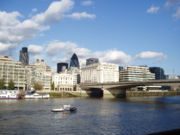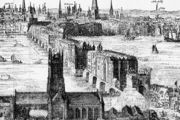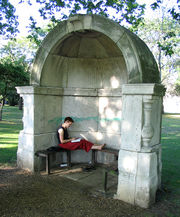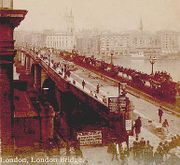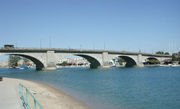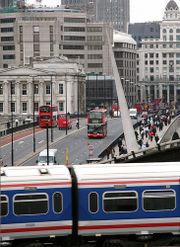London Bridge
2007 Schools Wikipedia Selection. Related subjects: Architecture
London Bridge is a bridge in London, England over the River Thames, between the City of London and Southwark. It is between Cannon Street Railway Bridge and Tower Bridge; it also forms the western end of the Pool of London. London's original bridge made this one of the most famous bridge emplacements in the world. It was the only bridge over the Thames in London until Westminster Bridge was opened in 1750.
On the south side of the bridge is Southwark Cathedral and London Bridge station. On the north side is the Monument to the Great Fire of London and Monument tube station.
The bridge is designated as part of the A3 road, maintained by the Greater London Authority.
Tower Bridge is sometimes mistakenly referred to as London Bridge.
History
A bridge has existed at or near the present site for nearly 2000 years. The first bridge across the Thames in the London area was built by the Romans on the present site around 46 AD and was made of wood. The location was most likely chosen as a bridgeable spot which still had deepwater access to the sea. The bridge fell into disrepair after the Romans left, but at some point either it was repaired or a new timber replacement constructed, probably more than once. In 1013, the bridge was burned down by King Aethelred in a bid to divide the invading forces of the Dane Svein Haraldsson. This episode might have inspired the well-known nursery rhyme London Bridge is Falling Down although the version of the song we know today refers to the many bridges that were destroyed and rebuilt, and the trading done on the shops over it ("Silver and Gold") in the 14th century so the song's origin is presumably of a much later date. The rebuilt London Bridge was destroyed by a storm in 1091 and yet again, this time by fire, in 1136.
Old London Bridge
Following the 1136 destruction of London bridge, its maintainer Peter de Colechurch proposed to replace the timber bridge with a permanent stone construction. A tax was levied to fund the new stone bridge, and construction of a new stone bridge was begun in the reign of Henry II, under de Colechurch's direction, in 1176. The new bridge took 33 years to complete and was not finished until 1209, four years after de Colechurch died, during the reign of King John.
John had the idea to build houses on the bridge, and it was soon colonised by houses, shops and even a chapel built at the centre of the bridge (dedicated to the recently martyred and canonised Thomas Becket who, appropriately, had been born in the parish of St Mary Colechurch). St. Thomas Chapel was grander than many small town parish churches. It even had a river level entrance for fishermen and those who taxied passengers across the river.
The medieval bridge had 19 small arches and a drawbridge with a defensive gatehouse at the southern end. Contemporary pictures show it crowded with buildings of up to seven stories in height. The narrowness of the arches meant that it acted as a partial barrage over the Thames, blocking an estimated 80% of the river flow and thereby making the river more susceptible to freezing over in winter. The current was further obstructed by the addition of water-wheels under the two north arches to drive water pumps, and under the two south arches to power grain mills. This produced ferocious rapids between the piers or "starlings" of the bridge, as the difference between the water levels on each side could be as much as six feet (two metres). Only the brave or foolhardy attempted to "shoot the bridge" – steer a boat between the starlings – and many were drowned trying to do so. As the saying went, the bridge was "for wise men to pass over, and for fools to pass under."
The decision of King John to allow shops built on London Bridge slowed down the traffic crossing the river. The houses and shops took up space and when carts broke down or animals revolted, crossing the bridge could take up to an hour. For this reason people on foot often chose to use the dozens of river taxi boats that quickly ferried Londoners from shore to shore.
Although the bridge itself was about twenty-six feet wide, the buildings on the bridge took up about seven feet on each side of the street. Some of these building projected another seven feet out over the river. The road for traffic was thereby reduced to just twelve feet wide. This meant that horses, carts, wagons, and pedestrians all shared a passage way just six feet wide, one lane going north and one south. There were a few places where houses and shops were not built. These breaks allowed people to get out of the pushing traffic and enjoy a glimpse of the Thames and the shorelines of London and Southwark.
Most people who visited the bridge, for reasons other than crossing the Thames, went there to shop. Nearly two hundred places of business lined both sides of the narrow street. Ale and beer were not sold on the London because these beverages required cool cellars, which were not possible in a building construction on a bridge. The merchants lived above their shops and sold goods from the street level floor. They used windows to show their goods and transact business. Over each shop hung a sign usually in the shape of the articles sold in order that the illiterate could recognize the nature of the business. These signs were posted high enough that a rider on a horse could pass beneath them. Every inch of the small street had to be available to vehicular traffic.
One of the benefits of shopping on London Bridge was that many of the top floors of the houses and shops were built over the street and actually connected to the house or shop across the street, giving the street a tunnel look. These connecting overhead structures provided shelter from the weather and was a forerunner of the modern shopping mall.
The gates to London Bridge were closed at curfew, and the bridge was regarded as a safe place to live or shop. Located neither in London nor in Southwark, the Bridge community was almost a town unto itself. The major thievery was the ever present pickpocket. Its greatest dangers were fire and death by drowning as few people knew how to swim. Additionally, the winter sounds of ice floes cracking and crashing into its nineteen piers must have caused bridge dwellers many a sleepless night.
Various arches of the bridge collapsed at various points, and houses on the bridge were burnt during Wat Tyler's Peasants' Revolt in 1381 and Jack Cade's rebellion in 1450, during which a pitched battle was fought on the bridge.
The northern gate, the New Stone Gate, was replaced by Nonesuch House in 1577. The southern gatehouse, the Stone Gateway, became the scene of one of London's most notorious sights: a display of the severed heads of traitors, impaled on pikes and dipped in tar to preserve them against the elements. The head of William Wallace was the first to appear on the gate, in 1305, starting a tradition that was to continue for another 355 years. Other famous heads on pikes included those of Jack Cade in 1450; Sir Thomas More in 1535; Bishop John Fisher, also in 1535; and Thomas Cromwell in 1540. A German visitor to London in 1598 counted over thirty heads on the bridge. The practice was finally stopped in 1660, following the Restoration of King Charles II.
The buildings on London Bridge created a major fire hazard and served to increase the load on its arches, so it is not surprising that there were several disasters on the bridge. In 1212, perhaps the greatest of the early fires of London broke out on both ends of the bridge simultaneously, trapping many in the middle and reportedly resulting in 3,000 people being killed. Another major fire broke out in 1633 with the northern third of the bridge being destroyed, although this prevented the bridge from being damaged by the Great Fire of London in 1666. By 1722, congestion was becoming so serious that the Lord Mayor decreed that "All carts, coaches and other carriages coming out of Southwark into this City do keep all along the west side of the said bridge: and all carts and coaches going out of the City do keep along the east side of the said bridge". This is possibly the origin of traffic in Britain driving on the left. Finally, in 1758–62, the houses were removed along with the two centre arches, replaced with a single wider span to improve navigation on the river.
New London Bridge
By the end of the 18th century, it was apparent that the old London Bridge — by now over 600 years old — needed to be replaced. It was narrow, decrepit, and blocked river traffic. In 1799, a competition for designs to replace the old bridge was held, prompting the engineer Thomas Telford to propose a bridge with a single iron arch spanning 600 ft (180 m). The revolutionary nature of this design won praise but it was never used, due to uncertainty about its feasibility and the amount of land needed for its construction.
The bridge was eventually replaced by an elegant structure of five stone arches, designed by engineer John Rennie. The new bridge was built 100 feet (30 m) west (upstream) of the original site at a cost of £2,000,000 and was completed by Rennie's son (of the same name) over a seven-year period from 1824 to 1831. The old bridge continued in use as the new bridge was being built, and was demolished after the new bridge opened in 1831.
Rennie's bridge was constructed from Dartmoor granite, with a length of 928 feet (283 m) and a width of 49 feet (15 m). The official opening took place on 1 August 1831; King William IV and Queen Adelaide attended a banquet in a pavilion erected on the bridge. The recently constructed HMS Beagle was the first ship to pass under it. It was widened in 1902–4 from 52 to 65 feet (16 to 20 m) in an attempt to combat London's chronic traffic congestion. Unfortunately, this proved too much for the bridge's foundations; it was subsequently discovered that the bridge was sinking an inch every eight years. By 1924, the east side of the bridge was some three to four inches lower than the west side; it soon became apparent that the old bridge would have to be removed and replaced with a more modern one.
On 18 April 1968, Rennie's bridge was sold to the American entrepreneur Robert P. McCulloch of McCulloch Oil for the sum of $2,460,000. It has been claimed that he was under the mistaken impression that he was buying the more impressive Tower Bridge, which is often erroneously thought of as 'London Bridge' by tourists, although McCulloch denied this. The bridge was reconstructed at Lake Havasu City, Arizona, and dedicated on October 10, 1971. Not all of the bridge was transported to America, as some was kept behind in lieu of tax duties.
The version of London Bridge that was rebuilt at Lake Havasu consists of a concrete frame with stones from the old London Bridge used as cladding. The remaining stone was left at Merrivale Quarry on Dartmoor in Devon, so a large part of Rennie's bridge never left the UK. When Merrivale Quarry was abandoned and flooded in 2003, the remaining stones were auctioned off. The reconstruction of Rennie's London Bridge spans a canal that leads from Lake Havasu to Thomson Bay, and forms the centrepiece of a theme park in English style, complete with mock- Tudor shopping mall. Rennie's London Bridge has become Arizona's second-biggest tourist attraction, after the Grand Canyon.
Modern London Bridge
The current London Bridge was constructed by contractors John Mowlem from 1967 to 1972, and opened by Queen Elizabeth II on 17 March 1973. It is a dull edifice comprising three spans of pre-stressed concrete cantilevers, paid for in part by the sale of the earlier Rennie bridge. It is 928 feet (283 m) long. The cost of £4 million was met entirely by the City of London's Bridge House Estates. The current bridge was built in the same location as Rennie's bridge, which was carefully demolished piece by piece as the new bridge was built, so the bridge would remain in use throughout.
In 1984 the British warship HMS Jupiter collided with London Bridge causing significant damage to both ship and bridge.
On Remembrance Day 2004, various London bridges were furnished with red lighting as part of a night-time flight along the river by wartime aircraft. The red lighting on London Bridge considerably improved its drab appearance, so it has been left on the bridge (but not the other bridges) and lights it at night.
